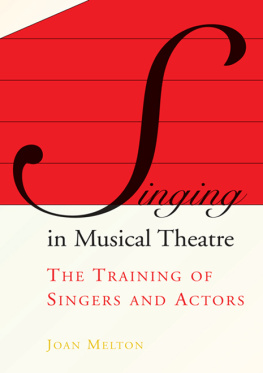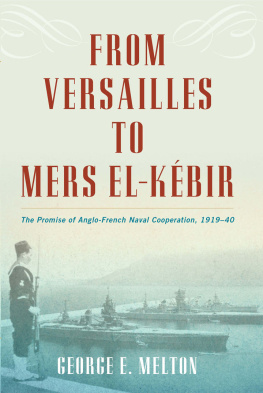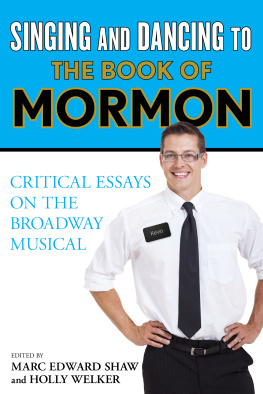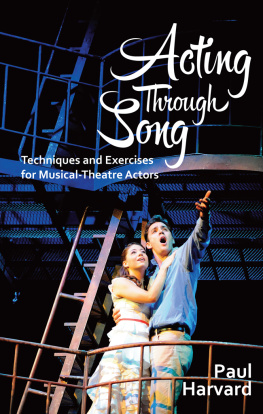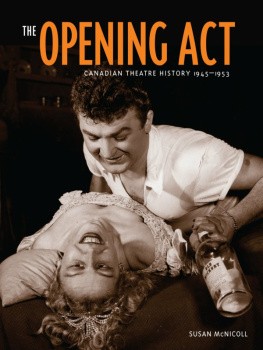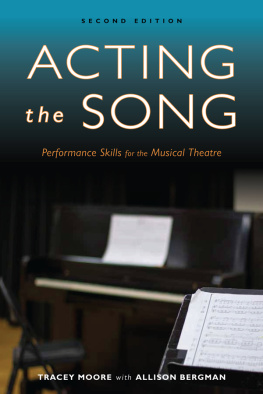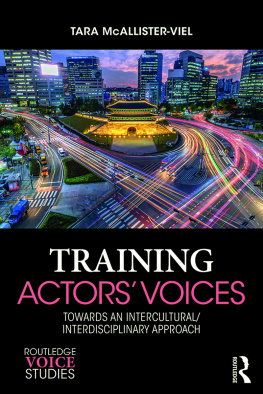Singing in Musical Theatre demystifies individual work that is generally unseen by the public or even by other singing teachersa generous act of the selected teachers, and also of Joan Melton, with her subtle and pointed questions that elicit full and illuminating answers.
Catherine Fitzmaurice, Founder of Fitzmaurice Voicework
There is no other book on the market that surveys the pedagogical practices of internationally recognized professional singing teachers... The book is structurally cohesive, soundly researched, and written by an author with a proven track record, who is a leading authority in the voice, singing, and acting fields.
Michael Lugering, author of The Expressive Actor:
Integrated Voice, Movement, and Acting Training
Music theatre singing stands at the crossroads of both classical and contemporary voice training. Joan Meltons new book explores this central issue for singers and singing teachers alike, providing lively insight into the state of knowledge and practicing pedagogy in this field. Highly recommended for anyone interested in teaching and learning about singing.
Dr. Rowena Cowley, Lecturer in Voice and Pedagogy,
Sydney Conservatorium of Music
S inging
in Musical Theatre
T HE T RAINING OF
S INGERS AND A CTORS
J OAN M ELTON

2007 Joan Melton
All rights reserved. Copyright under Berne Copyright Convention, Universal Copyright Convention, and Pan-American Copyright Convention. No part of this book may be reproduced, stored in a retrieval system, or transmitted in any form, or by any means, electronic, mechanical, photocopying, recording, or otherwise, without prior permission of the publisher.
11 10 09 08 07 5 4 3 2 1
Published by Allworth Press
An imprint of Allworth Communications, Inc.
10 East 23rd Street, New York, NY 10010
Cover design by Derek Bacchus
Interior design by Mary Belibasakis
Page composition/typography by Integra Software Services, Pvt., Ltd., Pondicherry, India
Library of Congress Cataloging-in-Publication Data
Melton, Joan.
Singing in musical theatre : the training of singers and actors / Joan Melton ; foreword by Angela Punch McGregor. p. cm.
Includes index.
ISBN-13: 978-1-58115-482-5 (pbk.)
ISBN-10: 1-58115-482-8 (pbk.)
eBook ISBN: 978-1-58115-809-0
1. Musical theaterInstruction and study. 2. SingingInstruction and study. 3. Voice teachersInterviews.
I. Title.
MT956.M45 2007
782.1'4143dc22
2007003757
Printed in Canada
C ontributors
ELISABETH HOWARD
WENDY LeBORGNE
JOAN LADER
JEANNETTE LoVETRI
MARY SAUNDERS-BARTON
NEIL SEMER
MARY HAMMOND
PENNI HARVEY-PIPER
GILLYANNE KAYES
LISA RYAN-McLAUGHLIN
JASON BARRY-SMITH
DEBBIE PHYLAND
JEAN CALLAGHAN
PAT WILSON
AMANDA COLLIVER
LIZ PASCOE
F OREWORD
I n 1995, I began a traumatic three-year project of training to become an actor who could sing. They were holding auditions for the musical Sunset Boulevard. A colleague foolishly remarked that it was a role I could and should play! Always up for a challenge, I decided to find a singing teacher who could quiet my nerves, and who could reassure me through every neurotic comment I would make about my throat, my vocal cords, my tone-deaf ear, my posture, my range, and so on. On top of that, this teacher would have to calmly coach and guide me from simple scales to a major role in a musical within twelve months.
I saw a poster advertising singing lessons on the front window of the Da Capo music store in Glebe, Sydney. In small letters at the bottom of the ad, it said: Tutor, Rita Hunter CBE!
To jump to the end of what is really a most unusual talewhere I could be treated to an aria from Madame Butterfly at 10:00 in the morning, and at such close range I would literally weep for the privilege of itI ended up forming a friendship with one of the greatest Wagnerian sopranos ever to walk this earth. This great singer and technician gave me an appreciation for the human voice I had never had in thirty years in the theatre. I will never sing Brunhilde, but I now have a far greater appreciation for the infinite possibilities of the vocal instrument.
Let me say that this book is an excellent and original voice manual. Joans research gives the reader entirely new information about vocal technique because of the wide variety of teaching methods exampled here. I have long held the belief that the young acting voice can benefit immeasurably via the strategies and techniques of singing training. For both singer and actor, the voice remains the same muscles that must be stretched, relaxed, toned, warmed, exercised, rested, adjusted, treated vigorously, and treated with tenderness. After all, singing is acting on pitch!
ANGELA PUNCH MCGREGOR
A CKNOWLEDGMENTS
F irst and most especially, I want to thank each of the sixteen contributors to this book. Their willingness to participate in the project, along with their generosity and expertise, make this a very special volume indeed. Each interviewee not only made time in an incredibly busy schedule for the interview itself, but also reviewed the written transcript and provided additional information to complete the work.
Secondly, I am deeply indebted to colleagues on three continents for their generous support and willingness to read parts of the manuscript. Thanks particularly to Jenny West and Angela Punch McGregor (Sydney); Katharine and Peter Watts (Auckland); Kevin Matherick (Carmarthen, Wales); Evelyn Carol Case, Maria Cominis, David Nevell, Kenneth Tom, Steve Magana, and Jim Volz (Cal State Fullerton); Chris Smith (San Juan Capistrano); Michael Lugering (Las Vegas); and Dan Kern (Philadelphia) for their positive comments, invaluable suggestions, and unflagging encouragement.
Special thanks to my students Noah Gillett, Lesley McKinnell, and Carly Menkin for their willingness to demonstrate the exercises in Chapter 19, and to Michael Puoci for photography.
Finally, my sincerest thanks to Nicole Potter-Talling, senior editor at Allworth Press, for her immediate and enthusiastic response to my vision, and her wisdom and guidance throughout the publication process.
JOAN MELTON
I NTRODUCTION
A s more and more classical singers consider the possibility of branching out into non-classical singing, and as actors acknowledge the very real possibility of getting more work if they can sing, musical theatre becomes a particularly attractive option for both groups. Yet the breadth of training and skill that is essential for musical theatre performance frequently comes as a surprise. For example, being a triple threat means lots of regular physical activity in the form of dance classes, movement work, theatre voice training, and, of course, actor training, in addition to regular lessons with a singing teacher and/or coach.
Singing for musical theatre is enormously demanding. It requires the ability to handle a wide variety of vocal genres, as well as the robust good health to do eight shows a week on a regular basis. Singing in Musical Theatre brings to one volume the insights and training perspectives of some of the most influential teachers of singing for musical theatre in the world today, through a series of personal interviews conducted in the United States, the United Kingdom, and Australia. Each of the master teachers interviewed has students and/or clients working in major theatres and/or touring productions in the United States, Great Britain, and/or Australia, as well as in other parts of the world. Each interviewee has been asked: (1) to discuss six major elements of voice training that relate directly to theatre voice: alignment, breathing, range, resonance, articulation, and connection, or the acting dimension; and (2) to relate her or his approach to voice science and to the movement-based work that is a core element of actor training. The interviews are presented in the order in which they were done, spring through fall of 2004.
Next page
